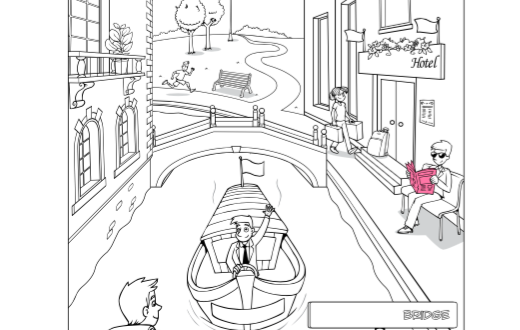About A1 Movers and A2 Flyers Listening Part 5 and how to do well
In both A1 Movers and A2 Flyers Listening Part 5, learners have to listen to a conversation between and adult and a child about a scene picture and colour things in the picture and also write words. (A1 Movers students will have to write one word and in A2 Flyers, there will be two words to write.)
Here is a sample picture for A2 Flyers Listening Part 5 from Sample Papers 1, available here.
The voices
There is an example, which will give students time to get used to the speakers’ voices and accents. As there is an adult and a child speaking, there should be no problem distinguishing between them.
Colouring things in the picture
Tip: Tell students that they are not being judged on their ability to colour! If they colour the right thing with the right colour, they will get the mark.
Careful! If they colour something in the picture that should not be coloured, they will lose a mark.
Sometimes, there are two objects – perhaps one big star and one small star, for example. Students must colour the right star.
If they realise that they have coloured the wrong star and cannot erase the colour, they should tell the invigilator at the end of the test. A note can be made regarding this.
Tip: Practise understanding (and using) prepositional phrases and comparatives to describe where something is and how big/small/old it is. Ask students to describe these things too as it is very useful real-life language!
Careful! Sometimes, and especially at A2 Flyers level, students only have to cover part of something – eg a pocket of a jacket or rucksack; the tail of an animal (or another part of its body), etc. If they colour the whole jacket or animal, they will not get the mark.
Writing words
Tip: The place to write the word is usually obvious!
Train students to look for:
boards (on boats, signs, walls….) There will often be part of the name on the board already and students have to write another word in front of/above/below that word. (e.g. ……………… Hotel).
boxes, bags There may be a clear area (e.g. a square) on these where students need to write a word.
posters, pictures Again, there may be a clear area (e.g. a square) on these where students need to write a word.
documents (books, papers, cards, postcards, envelopes)
transport (boats, planes, taxis, ….)
Have fun! Ask students to try and guess where they have to write a word, then listen and see if they were right!
Instructions for writing words
Instructions for writing words can come in various formats. Some are easier than others.
Easiest:
1 Completing a name
Put the word ………… before/after/above/below it.
* Learners often have problems with this ‘easy’ instruction because they merge the word ‘word’ with the word they have to write – e.g. Put the word ‘bird’ above it.
Learners start wondering what a ‘wordbird’ is!
Tip: Do lots of dictation practice with this: Write the word ‘bird’. Put ‘bird’ on the board. We call it ‘bird’.
More challenging instructions:
2 Writing the name
We call it …
Do you want to write the missing word?
3 Saying contents – then where to write
e.g. There’s rice inside. Write that word.
They look like potatoes. Can I write that?
The problem here is that students might understand a word, but not notice or remember it because the instruction to write that word comes after they hear it, not before.
Even more challenging instructions:
4 Changing your mind
One of the speakers says what to write, but then another word is chosen instead. Students have often already started to write the first word and have to erase it.
e.g. No. Write ‘noodles’ instead.
Sorry, I mean ‘noodles’.
Have fun! Get students to write instructions.
Show them the different ways to write the instructions. They choose a picture in their coursebook or a magazine, decide on a place to write a word, and write the instructions on a piece of paper.
They pass on their instruction to another group, who have to find the picture and write the word (use post-its for them to write the word on and stick it in the place in the correct picture).
We call it …
e.g. There’s (…..) inside. Write that word.
They look like (……….). Can I write that?
Shall I write the word (……)?
No. Write (………) instead.
Sorry, I mean (……..)


